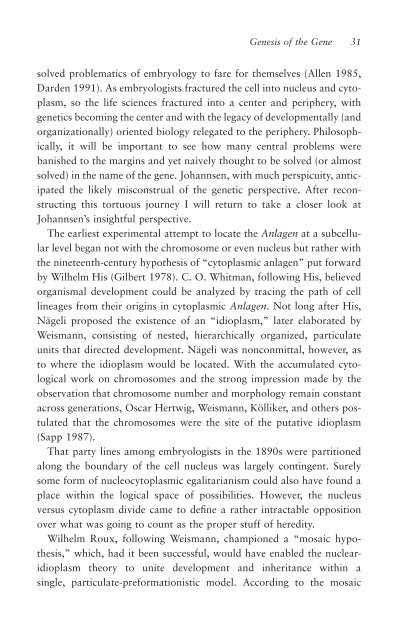A Critique of Pure (Genetic) Information
A Critique of Pure (Genetic) Information
A Critique of Pure (Genetic) Information
Create successful ePaper yourself
Turn your PDF publications into a flip-book with our unique Google optimized e-Paper software.
Genesis <strong>of</strong> the Gene 31<br />
solved problematics <strong>of</strong> embryology to fare for themselves (Allen 1985,<br />
Darden 1991). As embryologists fractured the cell into nucleus and cytoplasm,<br />
so the life sciences fractured into a center and periphery, with<br />
genetics becoming the center and with the legacy <strong>of</strong> developmentally (and<br />
organizationally) oriented biology relegated to the periphery. Philosophically,<br />
it will be important to see how many central problems were<br />
banished to the margins and yet naively thought to be solved (or almost<br />
solved) in the name <strong>of</strong> the gene. Johannsen, with much perspicuity, anticipated<br />
the likely misconstrual <strong>of</strong> the genetic perspective. After reconstructing<br />
this tortuous journey I will return to take a closer look at<br />
Johannsen’s insightful perspective.<br />
The earliest experimental attempt to locate the Anlagen at a subcellular<br />
level began not with the chromosome or even nucleus but rather with<br />
the nineteenth-century hypothesis <strong>of</strong> “cytoplasmic anlagen” put forward<br />
by Wilhelm His (Gilbert 1978). C. O. Whitman, following His, believed<br />
organismal development could be analyzed by tracing the path <strong>of</strong> cell<br />
lineages from their origins in cytoplasmic Anlagen. Not long after His,<br />
Nägeli proposed the existence <strong>of</strong> an “idioplasm,” later elaborated by<br />
Weismann, consisting <strong>of</strong> nested, hierarchically organized, particulate<br />
units that directed development. Nägeli was nonconmittal, however, as<br />
to where the idioplasm would be located. With the accumulated cytological<br />
work on chromosomes and the strong impression made by the<br />
observation that chromosome number and morphology remain constant<br />
across generations, Oscar Hertwig, Weismann, Kölliker, and others postulated<br />
that the chromosomes were the site <strong>of</strong> the putative idioplasm<br />
(Sapp 1987).<br />
That party lines among embryologists in the 1890s were partitioned<br />
along the boundary <strong>of</strong> the cell nucleus was largely contingent. Surely<br />
some form <strong>of</strong> nucleocytoplasmic egalitarianism could also have found a<br />
place within the logical space <strong>of</strong> possibilities. However, the nucleus<br />
versus cytoplasm divide came to define a rather intractable opposition<br />
over what was going to count as the proper stuff <strong>of</strong> heredity.<br />
Wilhelm Roux, following Weismann, championed a “mosaic hypothesis,”<br />
which, had it been successful, would have enabled the nuclearidioplasm<br />
theory to unite development and inheritance within a<br />
single, particulate-preformationistic model. According to the mosaic
















